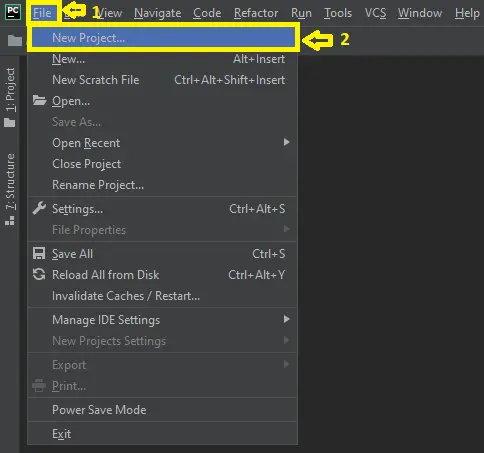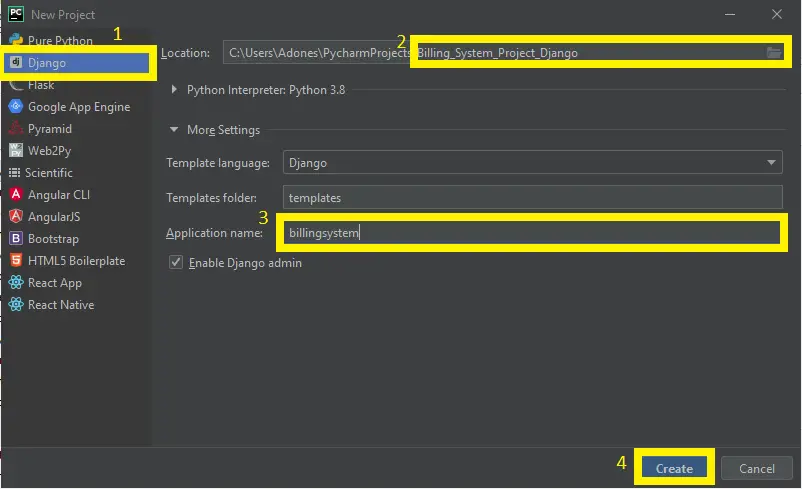Billing System Project in Django with Source Code
This Billing System Project in Django created based on python, Django, and SQLITE3 Database. This project it’s available for free download.
You can use it offline or on the web after you’ve downloaded it. Many features are included inside the program, which you can use without having to create a manual bill.
To start creating a Billing System Project in Python Django, makes sure that you have PyCharm Professional IDE Installed in your computer.
This Billing System Project in Django Framework, Also includes a Download Source Code for free, just find the downloadable source code below and click download now.
| About Project | Project Details | Definition |
|---|---|---|
| Project Name | Billing System Project in Django with Source Code | A Billing System Project in Django is an easy project for beginners to learn how to build a web-based python Django project. We will provide you with the complete source code and database for the python project so that you can easily install it on your machine and learn how to program in Python Django. |
| Python version (Recommended) | 3.8 Version | Python 3.8 introduces some new syntax to the language, as well as a few small modifications to existing behavior and, most importantly, a slew of performance improvements, following in the footsteps of the previous 3.7 version. |
| Programming Language Used | Python Django Language | Django is a high-level Python web framework for building safe and maintainable websites quickly. Django is a web framework built by experienced developers that takes care of a lot of the heavy lifting so you can focus on developing your app instead of reinventing the wheel. |
| Developer Name | itsourcecode.com | Free projects containing source code in Java, PHP, Python, Django, VB.Net, Visual Basic, C, C++, C#, Javascript, and other languages are available on this website. |
| IDE Tool (Recommended) | Sublime, Visual Studio, PyCharm | Sublime Text is a source code editor that is available for purchase. It comes with built-in support for a variety of programming and markup languages. Plugins, which are often community-built and maintained under free-software licenses, allow users to extend the functionality of the system. Sublime Text has a Python API to help with plugins. |
| Project Type | Web Application | A web application, unlike computer-based software programs that operate locally on the device’s operating system, is application software that runs on a web server. The user uses a web browser with an active network connection to access web apps. |
| Database | SQLite | SQLite is a programming language that is used to create embedded software for devices such as televisions, cell phones, and cameras. It can handle HTTP requests with low to medium traffic. SQLite has the ability to compress files into smaller bundles with less metadata. SQLite is a temporary dataset that is used within an application to process data. |
Billing System Project in Django Steps on How to Create a Project
Time needed: 5 minutes
Here are the steps on how to create a Billing System Project in Django with Source Code.
- Step 1: Open file.
First , open “pycharm professional” after that click “file” and click “new project”.

- Step 2: Choose Django.
Next, after click “new project“, choose “Django” and click.

- Step 3: Select file location.
Then, select a file location wherever you want.

- Step 4: Create application name.
After that, name your application.

- Step 5: Click create.
Lastly, finish creating project by clicking “create” button.

- Step 6: Start Coding.
Finally, we will now start adding functionality to our Django Framework by adding some functional codes.
Functionality and Codes of the Billing System Project in Django
- Create template for the menu in Billing System Project Project in Django.
In this section, we will learn on how create a templates for the menu. To start with, add the following code in your menu.html under the folder of bills/templates/bills.
{% load keyy %}
<!doctype html>
<html lang="en">
<head>
<!-- Required meta tags -->
<meta charset="utf-8">
<meta name="viewport" content="width=device-width, initial-scale=1, shrink-to-fit=no">
<!-- Bootstrap CSS -->
<link rel="stylesheet" href="https://stackpath.bootstrapcdn.com/bootstrap/4.1.1/css/bootstrap.min.css" integrity="sha384-WskhaSGFgHYWDcbwN70/dfYBj47jz9qbsMId/iRN3ewGhXQFZCSftd1LZCfmhktB" crossorigin="anonymous">
<title>Menu</title>
</head>
<body>
<center><h1>{{ title }}</h1></center>
<center>
<div class='container'>
<div class='row'>
<div class='col'>
<div class='col-sm-6 col-sm-12'>
<h3>Menu Options</h3>
Name:{{ Name }}<br>
Mob.No:{{ mobilenumber }}
<form method='POST' action="{% url 'bill:cal_amount' %}" name= 'myform'>
{% csrf_token %}
<input type="hidden" name="name" value="{{ Name }}">
<input type="hidden" name="mobilenumber" value="{{ mobilenumber }}">
<table>
<tr>
<th>Items-Name</th> 
<th><center>Quantity</center></th> 
<th><center>Price[Per_units]</center></th>
</tr>
{{ product.count }}
{% for p in products %}
<tr>
<td>{{ p.product_name }}</td> 
<td><input type="number" min="0" name="q_id_{{ p.product_id }}"></td> 
<td><center>{{ p.product_price }}</center></td>
</tr>
{% endfor %}
</table>
<br><button type="submit" class="btn btn-primary">Submit</button>
</form>
</div>
</div>
</div>
</div>
</center>
<!-- Optional JavaScript -->
<!-- jQuery first, then Popper.js, then Bootstrap JS -->
<script src="https://code.jquery.com/jquery-3.3.1.slim.min.js" integrity="sha384-q8i/X+965DzO0rT7abK41JStQIAqVgRVzpbzo5smXKp4YfRvH+8abtTE1Pi6jizo" crossorigin="anonymous"></script>
<script src="https://cdnjs.cloudflare.com/ajax/libs/popper.js/1.14.3/umd/popper.min.js" integrity="sha384-ZMP7rVo3mIykV+2+9J3UJ46jBk0WLaUAdn689aCwoqbBJiSnjAK/l8WvCWPIPm49" crossorigin="anonymous"></script>
<script src="https://stackpath.bootstrapcdn.com/bootstrap/4.1.1/js/bootstrap.min.js" integrity="sha384-smHYKdLADwkXOn1EmN1qk/HfnUcbVRZyYmZ4qpPea6sjB/pTJ0euyQp0Mk8ck+5T" crossorigin="anonymous"></script>
</body>
<script type="text/javascript">
function submitform()
{
var formData = JSON.stringify($("#myform").serializeArray());
console.log(formData)
}
</script>
</html>- Create template for the list form in Billing System Project Project in Django.
In this section, we will learn on how create a templates for the list form. To start with, add the following code in your list.html under the folder of bills/templates/bills.
<form method='POST' action="{% url 'bill:db_entry' %}">
{% csrf_token %}
<input type="hidden" name="name" value="{{ Name }}">
<input type="hidden" name="mobilenumber" value="{{ mobilenumber }}">
<table>
<tr>
<th>Items-Name</th> 
<th><center>Quantity</center></th> 
<th><center>Price[Per_units]</center></th>
</tr>
{% for p in products %}
<tr>
<td>{{ p.product_name }}</td> 
<td><input type="number" min="0" name="{% {} %}" value="0"></td> 
<td><center>{{ p.product_price }}</center></td>
</tr>
{% endfor %}
</table>
<br><button type="submit" class="btn btn-primary">Submit</button>
</form>
- Create template for the base in Billing System Project Project in Django.
In this section, we will learn on how create a templates for the base. To start with, add the following code in your index.html under the folder of bills/templates/bills.
<!doctype html>
<html lang="en">
<head>
<!-- Required meta tags -->
<meta charset="utf-8">
<meta name="viewport" content="width=device-width, initial-scale=1, shrink-to-fit=no">
<!-- Bootstrap CSS -->
<link rel="stylesheet" href="https://stackpath.bootstrapcdn.com/bootstrap/4.1.1/css/bootstrap.min.css" integrity="sha384-WskhaSGFgHYWDcbwN70/dfYBj47jz9qbsMId/iRN3ewGhXQFZCSftd1LZCfmhktB" crossorigin="anonymous">
<title>Billing System</title>
</head>
<body>
<center><h1>{{ title }}</h1></center>
<div class='container'>
<div class='row'>
<div class='col'>
<div class='col-sm-6 col-sm-12'>
<form method='POST'>
{% csrf_token %}
{{ form }}
<br><button type="submit" class="btn btn-primary">Submit</button>
</form>
</div>
</div>
</div>
</div>
<!-- Optional JavaScript -->
<!-- jQuery first, then Popper.js, then Bootstrap JS -->
<script src="https://code.jquery.com/jquery-3.3.1.slim.min.js" integrity="sha384-q8i/X+965DzO0rT7abK41JStQIAqVgRVzpbzo5smXKp4YfRvH+8abtTE1Pi6jizo" crossorigin="anonymous"></script>
<script src="https://cdnjs.cloudflare.com/ajax/libs/popper.js/1.14.3/umd/popper.min.js" integrity="sha384-ZMP7rVo3mIykV+2+9J3UJ46jBk0WLaUAdn689aCwoqbBJiSnjAK/l8WvCWPIPm49" crossorigin="anonymous"></script>
<script src="https://stackpath.bootstrapcdn.com/bootstrap/4.1.1/js/bootstrap.min.js" integrity="sha384-smHYKdLADwkXOn1EmN1qk/HfnUcbVRZyYmZ4qpPea6sjB/pTJ0euyQp0Mk8ck+5T" crossorigin="anonymous"></script>
</body>
</html>Downloadable Source Code Below.
Anyway, if you want to level up your programming knowledge, especially python, try this new article I’ve made for you Best Python Projects with source code for Beginners.
But If you’re going to focus on web development using Django, you can download here from our list of Best Django Projects with source code based on real-world projects.
How To Run The Billing System in Django?
- Step 1: Extract/unzip the file
- Step 2: Go inside the project folder, open cmd and type the following commands to install Django Framework and run the webserver:
- python manage.py migrate
- python manage.py runserver
- Step 3: Finally, open the browser and go to http://127.0.0.1:8000/
Summary
In summary, this 2022 Billing System Project in Django with Source Code can be useful to students or professional who wants to learn python programming language.
This project can also be modified to fit your personal requirements. Hope this project will help you to improve your skills. Happy Coding!
- How To Make A Point Of Sale System In Python
- Best Python Projects for Beginners
- Python MySQL Connection: Simple Python Step by Step Guide
- Python PIP Command Set-up / Fix: Step by Step Guide
- Random Password Generator in Python Projects With Source Code 2020
- Python Range Function|Range in Python Explained with Examples 2020
- School Management System Project In Django With Source Code
- Django Login And Registration With Source Code
- CRUD App In Django With Source Code
- Drag And Drop JavaScript With Source Code
- Todo List App Django With Source Code
Inquiries
If you have any questions or suggestions about Billing System Project in Django with Source Code, please feel free to leave a comment below.






Morning
I just had a look at your Youtube channel. I want your help in this regard as I have a company involved with a similar system in the injury on duty sector.
Currently we are working on SQL and we utilise Excell as a tool to do this.
I love the way your site looks and works. I have intermediate skills with Python and Django.
What is your tariffs, for development?
A typical model would be
Medical Practice
Patient/Employee
Invoices
Funders that pay these invoices, as it is injury on duty
But I will explain in full if we could work on this together.